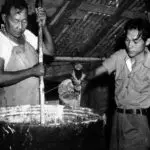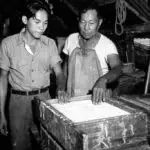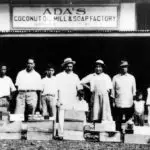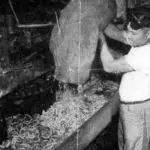Josef Martinez Ada
Table of Contents
Share This
Maker of coconut soap
Josef Martinez Ada (1885 – 1955) founded Ada’s Soap Factory, which was Guam’s most successful soap factory from the early 1930s until his death and Guam’s first locally owned and operated soap factory. His soap was made from coconut oil using recipes and techniques he learned in Germany as a student. Ada is the grandfather of former Governor Joseph F. Ada, whose son Eric revived the soap business as Hafa Adai Soap, Inc. in recent years.
Born in Guam, Josef Ada moved to Saipan when he was young, as his father, Pedro, was in charge of copra-producing coconut groves throughout the Marianas. The northern islands were under German administration, and Pedro Ada worked as an interpreter for the Germans. Through his affiliation with the German administration, Pedro secured rights to produce copra in the northern Marianas, and formed the successful Pagan Copra Company.
Josef also learned German and served as a translator, and he and his brother, Antonio, were selected by the German governor in 1906 for schooling in Germany. Josef went to study bookkeeping, and later studied baking, photography, and soap-making. He stayed in Germany for 18 months with a family that owned and operated a soap mill, where he learned the skill of soap-making. He then returned to Saipan and opened a soap factory.
He encountered some difficulty at first, as the climate differences between Saipan and Germany led to problems with the quality of his soap. He didn’t give up, corresponding with friends in Germany and finding the necessary adjustments to produce quality soap.
When Pedro Ada died in 1911, Antonio returned to Saipan to help Josef run the now-successful soap business. The soap was not only sold locally, it was exported to the Caroline Islands and even Shanghai. After World War I, however, the business saw a decline in sales. Antonio passed away in 1928, and the Ada family returned to Guam.
Josef established Ada’s Soap Factory in the Anigua district of Hagåtña, but faced stiff competition from other manufacturers, especially Vives Coconut Oil Mill. But with the help of his sons, Josef turned his factory into a thriving business. The family was especially proud to be the first soap-making business owned and operated by CHamorus, and this fact along with the reputation “for high-quality soap helped sales to grow.
Ada’s soaps eventually surpassed the other leading brands, jumping from sales of 679 to 2,400 bars in just one year (1933-34). The factory produced and sold the bulk of all soap used in Guam, and was increasingly popular in areas such as the Caroline Islands, Marshall Islands and New Guinea.
The success of the local soap-making opened a large market for producers of copra, which is dried coconut meat that yields pure coconut oil. The soap factory relied heavily on many small farmers who produced copra at their ranches. The people of Guam became so heavily dependent on Ada’s soap that when the factory was destroyed in 1944 during World War II, soap became very scarce.
With the help of his sons, Josef worked hard to rebuild the factory with materials salvaged from war rubble and to meet the large demand for soap. The factory was nowhere near its pre-war condition, and soap had to be made by hand as machinery was destroyed during the war. Copra was also scarce, as most of the island’s coconut trees were destroyed in the bombing of 1944. “Tun Josef,” as he was also known, was often seen combing the island in search of copra during the early morning hours.
Island leaders made an effort to step up soap production, and villages were asked to fulfill quotas of copra each month. Tun Josef also found his sugar cane crusher machine, taken by the Japanese during the war and abandoned in the jungle. With the increased copra and this machine, the factory again became a successful business. However, when Tun Josef died in 1955, the factory shut down with him.
Tun Josef, the son of Maria Martinez and Pedro Pangelinan Ada, was married to the former Maria Perez Torres. The couple had 10 children.
For further reading
I Manfåyi: Who’s Who in Chamorro History. Vol. 1. The Hale’-ta Series. Hagåtña: Political Status Education and Coordinating Commission, 1995.




